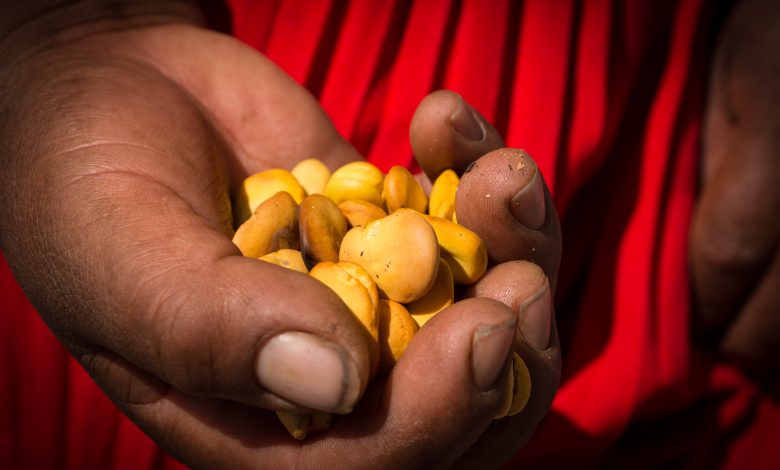Peruvian Snacks, From Rural Tradition to Global Markets

On the hour flight from Lima to Cusco, recently, instead of the small ham sandwich and cake the flight attendants handed out small packages of toasted habas, that is broad beans or fava beans. These are as Peruvian as the hairless dogs, but they are also a change.
The Peruvian airline is following in the footsteps of United States Airlines in reducing costs as much as possible, including reducing service to find the points where passengers do more than scream; they quit buying tickets. This rush to the bottom of the maximization curve–the point of maximum profits for the least costs–is not new in Peru though it is growing strongly with Peru’s adoption of global neoliberalism in which it has become deeply engaged with the United States.
Let’s stay away from that stuff for now. There is another change afoot here.
Broad beans and other toasted and popped grains and seeds are found on many an Andean street corner, both in Peru and the other Andean countries. I used to keep a small bag of toasted peas in my pocked to munch on whenever I felt the need for a little burst of energy in Bolivia where I then lived. Habas, were more common though, whether still in their blackened shells or shelled and in small bags of toasted beans.
In Cusco you find these, parched corn (cancha), toqto (cancha with crispy pork rind), chifles (crisp fried plantains), mana (sweetened popped giant corn), and so on. Of them, the habas strongly remind of rural Peru (huelen a campo–as they say here). These foods are a way in which people can take a simple product many farmers raise (broad beans) and give them added value by toasting them, something they traditionally do. Then they can take and sell these on street corners for little additional cost. They may have to by small plastic bags or they may make cones of paper.

This food has jumped from street corners and rural hands to those of agroindustry. They are now mass produced, packaged industrially and offered on airplanes and in quality formal stores in Peru and abroad.

Not only that, habas also has a new category now. I always heard them called tostadas when people wanted to locate them in something more general. Tostadas are just things that are toasted. The word referred to the technique by which they are produced, something that has roots deep into the Peruvian past as one of the main Pre-Colombian cooking techniques, transforming something through dry heat.
Now, they are called “snacks”. This is an English word that used to refer, in Peru, to sandwiches or other food you could find and consume quickly in restaurants called “snacks”. Now the word joins potato chips, peanuts and raisins, and chifles (from the domain that used to be called botanas) to be more like the English meaning of snack.
The word means something small and in between meals. It also refers to things that come in formal packages, the way you buy them in a grocery store. They are seldom made artisanally and you certainly almost never find people selling them in parking lots and street corners
With these packaged treats Peru creates a niche for itself in a multinational snack food industry in which potato chips constitute the largest share of revenue followed very closely by roasted nuts and seeds.
Externally and in formal markets within the country, Peru is claiming more shelf space and market visibility for “indigenous” products. Not to long ago, though, the Peruvian elites that produce these would have rejected them as low status and of low “quality” in the face of North American or European products. The formal producing, packaging, and marketing makes them more palatable and acceptable in that world.
These products are produced by rural cooperatives, such as the Cooperativa Agroindustrial del Valle Sagrado a group of farmers from Cusco’s Sacred Valley, who made the packaged and spicy canchitas I bought from a store and had yesterday in Calca. They are especially made by improtant Peruvian industries such as the Comercia Carter which made the habas I had on the airplane.
Comercia Carter opens another intriguing twist to this story. It is owned by the agrochemical Corporacion Custer. The last name Custer should sound very familiar to devotees of Peruvian food. Tony Custer, the Harvard educated head of the Custer Corporation was troubled, the story goes, when he looked for a Peruvian Cookbook in a fine bookstore in the US during the ’90s. He found nothing. This was before Copeland Marks had published his Exotic Kitchens of Peru.

With a background in marketing and business (Harvard MBA and a family industry in Peru), a background in music and an interest in other arts, as well as family in the food industry (his wife’s aunt, Marisa Guiulfo and her sons Coque and Felipe Ossio are prominent in Peruvian cuisine), Mr. Custer decided to create a cook book to put fine Peruvian cuisine on the map.
Unlike the habas his company now markets, this was not the ordinary cooking of Peru’s people with its diversity. Rather Custer decided to emphasize the cooking of Peru’s chefs at a time they were developing verve and presence. He also wanted fine photographs to show the beauty of Peruvian food at a time when presentation was all the buzz in the food world.
Custer’s the art of Peruvian Cuisine was first published in 2000 by Custer and has been a major success, such that Custer more than recouped his investment. Profits from this book and Volume 2 go towards Custer’s foundation to provide social benefit to poorer Peruvians.
Not only was Custer key in bringing haute Peruvian cuisine before the world, his Carter enterprise hopes to take reformulated and humble Peruvian foods and present them as quality products in the ordinary world of snack foods.




